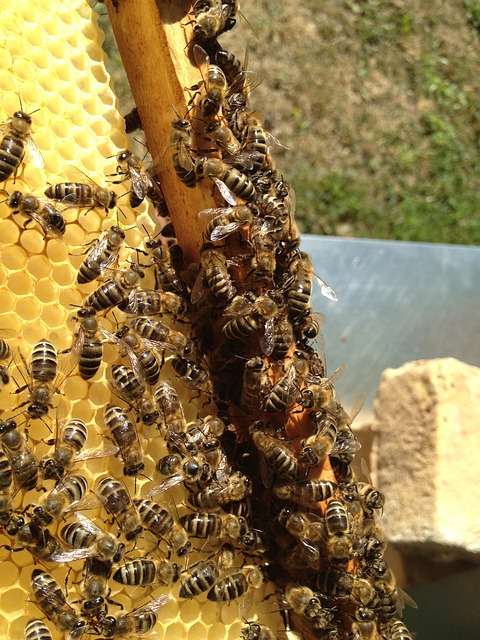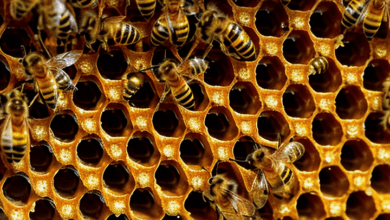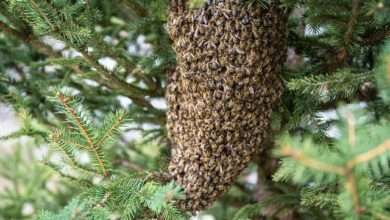The Intriguing Concept of Bee Space: Exploring the Fascinating Capacity that Governs Beehive Architecture

In the world of beekeeping, it is crucial to understand the concept of Bee Space. This seemingly small gap, meticulously measured to an exact dimension, plays a vital role in the life of honeybees and the art of beekeeping.
Bee Space refers to the ideal gap or distance between hive components, where honeybees have just enough room to move and work efficiently.
In this article, we will delve into the historical background of Bee Space, explore its significance in hive design and management, and highlight its importance for colony health and honey production. Join us as we unravel the intricacies of Bee Space and discover its remarkable impact on the world of beekeeping.
Historical Background
The discovery of Bee Space is attributed to the observation and research of numerous renowned figures in the field of beekeeping. One such figure is Lorenzo Langstroth, an American apiarist who, in the mid-19th century, revolutionized beekeeping with his scientific investigations into bee behavior. Langstroth recognized the importance of maintaining proper space within hives, which led to his development of the moveable frame hive. This innovation not only allowed beekeepers easier access for hive inspections but also provided bees with the perfect Bee Space, promoting healthier and more productive colonies.
Before Langstroth’s groundbreaking work, beekeeping methods lacked an understanding of Bee Space, leading to challenges in managing hive populations and honey production.
Understanding Bee Space
Understanding the concept of bee space is essential for any aspiring beekeeper, as it greatly impacts the overall well-being of the colony and the quantity of honey produced.
Definition and Measurement of Bee Space
Bee space refers to the optimal space or gap within a beehive that allows honeybees to move and operate comfortably without hindrance. This crucial discovery revolutionized modern beekeeping practices.
The measurement of bee space ideally ranges between 1/4 inch (6.35 mm) to 3/8 inch (9.5 mm). It is of utmost importance to maintain this specific measurement because anything smaller or larger hinders the bees’ smooth movement, affecting their efficiency and productivity.
Importance of Bee Space for Honeybees
Bee space holds immense significance for honeybees due to their instinctive behaviors and natural tendencies. Honeybees are meticulous creatures that meticulously maintain their hive’s integrity, cleanliness, and temperature. The presence of appropriate bee space allows bees to move and work harmoniously, facilitating their daily tasks.
Utilization of Bee Space for Hive Maintenance
Bees utilize the bee space within the hive for various maintenance activities to ensure the overall well-being of the colony. They utilize the available space to construct comb cells, create passageways for movement, and allow for storage and distribution of food resources. Moreover, the bee space allows them to regulate the hive’s temperature by using their wings to fan or circulate air throughout the nest.
Significance of Bee Space in Beekeeper Management Practices
For beekeepers, understanding bee space is vital for proper management and manipulation of their hives. By maintaining the prescribed bee space, beekeepers can easily inspect the colony, monitor its health, and provide necessary interventions when needed. Any deviation from the appropriate bee space can lead to countless complications, making hive management arduous for both the bees and the beekeeper.
Impact of Bee Space on Honey Production
The impact of bee space on honey production is undeniable. The prescribed bee space allows honeybees to work efficiently, ensuring a smooth flow of nectar collection, honey production, and pollen storage. When bee space is adequately maintained, honeybees can maximize their efforts, resulting in abundant honey harvests for the beekeeper.
Utilizing Bee Space in Hive Design
Here, we will explore the various aspects of bee space utilization in different components of a hive, highlighting its significance in beekeeping practices.

Bee Space Requirements for Wooden Frames and Hive Boxes
When constructing wooden frames and hive boxes, it is essential to account for bee space. Bees need enough room to move freely between frames without feeling cramped, ensuring optimal hive functionality. To achieve this, a standardized bee space of approximately 3/8 inch (9.5mm) is often recommended for wooden frames and hive boxes. This uniform spacing allows bees to navigate between frames, inspect combs, and carry out their tasks efficiently.
Considerations for Bee Space in Foundation Frames and Comb Attachment
Foundation frames play a critical role in bee space management within hives. It is important to ensure that the foundation is installed correctly to maintain proper bee space. Bees typically build honeycomb cells measuring around 5/16 inch (8mm) in diameter.
Therefore, foundation frames with base cells of similar dimensions facilitate natural comb attachment by bees. By providing bees with a foundation that accommodates their natural comb-building instincts, beekeepers can effectively manage bee space in the hive.
Utilizing Bee Space in Hive Entrances and Ventilation
Bee space is equally relevant in hive entrances and ventilation systems. Bees require adequate space to enter and exit the hive smoothly, enabling them to forage and fulfill their essential roles within the colony. By establishing an entrance with optimal bee space – often around 3/8 to 5/16 inch (9.5-8mm) – beekeepers can promote efficient traffic flow and prevent congestion, ensuring the overall health and productivity of the hive.
Proper ventilation within the hive is also essential, as it helps regulate temperature, humidity, and air circulation. Ventilation components should be designed with consideration for bee space, allowing bees to move freely while maintaining an optimal hive environment.
The Role of Bee Space in Queen Excluders and Honey Extraction
In beekeeping, queen excluders are frequently used to confine the queen to the brood chamber, preventing her from entering honey supers. Proper bee space is crucial when employing queen excluders, as it ensures that worker bees can easily pass through while restricting the larger queen.
Careful management of bee space in queen excluders allows for efficient honey production and simplifies honey extraction processes. Honey supers themselves should also incorporate suitable bee space to facilitate bee movement and comb construction, enhancing overall hive productivity.
Innovations in Hive Design and Bee Space Utilization
Beekeepers and hive designers continue to innovate, exploring new ways to optimize bee space utilization and hive functionality.
Various advancements have been made to improve honeybee colony management, such as the development of modular hive systems with adjustable bee space options. This innovation allows beekeepers to adapt the bee space within hive components to cater to specific colony requirements and environmental conditions.
By embracing such advancements, beekeepers can enhance honeybee health, productivity, and overall hive management.
Bee Space Management for Healthy Colonies
Importance of Maintaining Proper Bee Space for Colony Development
Proper Bee Space plays a pivotal role in the successful growth and development of honey bee colonies. Bees require specific measurements between their combs to allow for efficient movement, ventilation, and temperature regulation within the hive.
Failing to maintain the correct Bee Space can lead to various issues, such as reduced honey production, increased discomfort for the bees, and even aggression. Therefore, beekeepers must prioritize the maintenance of adequate Bee Space.
Ensuring Bee Space Stability During Hive Inspections
Hive inspections are necessary to monitor the health of honey bee colonies and address any potential issues promptly. However, these inspections can inadvertently disrupt Bee Space if not conducted with care.
To avoid disturbing the Bee Space, beekeepers must adopt specific techniques. One such method is using bee-friendly tools and equipment that minimize comb damage. Beekeepers should also handle frames gently and avoid unnecessarily shifting or rotating them. By employing these practices, beekeepers can maintain the integrity of the Bee Space during hive inspections.
Tips for Effective Bee Space Management
Beekeepers must actively manage Bee Space to promote colony well-being. Here are some essential tips for effective Bee Space management:
- Use standardized equipment: Utilize hive components that adhere to established beekeeping standards, ensuring the proper Bee Space measurements are maintained.
- Regular inspections: Conduct routine inspections to identify any comb disturbances or deviations from the ideal Bee Space. Promptly rectify any abnormalities to maintain colony health.
- Frame spacing: Maintain consistent spacing between frames, allowing bees to move comfortably between combs without excess constriction or empty space.
- Removing burr comb: Monitor and remove any burr comb, which is comb built outside the designated frames. This helps maintain optimal Bee Space and prevents bee squishing during inspections.
Impact of Bee Space on Disease Prevention in Beehives
Proper Bee Space management significantly contributes to disease prevention within honey bee colonies. Maintaining adequate space between combs allows bees to move freely and promotes hygienic behaviors.
When Bee Space is compromised, bees may not have enough room to groom each other, potentially leading to higher rates of mites, pests, or diseases. By prioritizing Bee Space management, beekeepers actively reduce the risk of disease transmission and promote healthier colonies.
Bee Space Management Techniques to Avoid Swarming
Swarming, the natural reproductive process of honey bees, can have detrimental effects on colony productivity if not properly managed. Beekeepers can employ specific Bee Space management techniques to minimize swarming tendencies:
- Provide additional space: As colonies expand, offering additional supers or honey chambers provides bees with ample space to store surplus honey and reduce congestion within the hive.
- Checkerboarding: Implementing the checkerboarding technique involves alternating empty frames with frames containing brood or honey. This manipulation creates the illusion of space, discouraging the bees from initiating the swarming process.
- Super rotation: Regularly rotating supers between hives can disrupt the swarming impulse by creating a perceived change in hive conditions, reducing congestion, and promoting colony expansion.
Common Challenges and Solutions
Inadequate Bee Space can lead to various problems and hinder the productivity of the hive.
Common problems due to inadequate Bee Space
Insufficient Bee Space can give rise to various issues within a beehive, including:
- Congestion: When Bee Space is not appropriately maintained, bees may have difficulty moving between frames, leading to congestion and reduced efficiency.
- Unfavorable Comb Construction: Bees require adequate space to build their honeycomb properly. Insufficient Bee Space may result in irregular or misaligned comb construction, making it challenging for beekeepers to manage the hive.
- Increased Swarming Tendency: Bees may become more prone to swarming if they feel cramped in their hive due to inadequate Bee Space. Swarm management becomes crucial to prevent the loss of valuable bee populations.
How to identify and rectify issues related to Bee Space
It is essential for beekeepers to identify and rectify any Bee Space-related problems promptly. Here are some steps to address such issues:
- Regular Inspections: Conduct frequent hive inspections to observe bee behavior and assess the availability of sufficient Bee Space.
- Frame Spacing: Maintain an appropriate space of 3/8 to 5/16 inch (9.5 to 8 mm) between frames to ensure optimal Bee Space.
- Comb Management: Replace or repair comb with irregular construction to provide bees with a suitable space for their activities.
- Hive Manipulation: Introduce additional frames or supers when necessary to alleviate congestion and offer bees adequate space for expansion.
Beekeeper best practices for maintaining optimal Bee Space
Adhering to best practices can help beekeepers maintain optimal Bee Space and enhance hive productivity.
Consider the following guidelines:
- Regular Hive Maintenance: Conduct routine hive inspections, cleanings, and repairs to prevent obstructions or issues that could impede proper Bee Space.
- Frame Replacement: Replace old or damaged frames to ensure consistent and appropriate Bee Space.
- Consistency in Hive Design: Adopt standardized hive equipment to promote uniform Bee Space throughout the beekeeping operation.
- Education and Training: Stay updated with the latest beekeeping practices and techniques to effectively manage Bee Space and address emerging challenges.
Innovations in hive technology to address Bee Space challenges
Advancements in hive technology have provided beekeepers with innovative solutions to overcome Bee Space challenges.
Some notable innovations include:
- Modular Hive Systems: These systems offer customizable hive components that allow beekeepers to adjust Bee Space according to their specific needs.
- Precision Manufacturing: Advanced manufacturing techniques ensure precise dimensions and tolerances in hive equipment, maintaining consistent and optimal Bee Space.
- Hive Monitoring Technology: Sensor-based systems can provide real-time data on hive conditions, allowing beekeepers to monitor Bee Space and address any deviations promptly.
The future of Bee Space research and its potential benefits to beekeeping
Bee Space research continues to evolve, presenting exciting opportunities to improve beekeeping practices. The future holds several potential benefits, including:
- Development of Hive Designs: Ongoing research aims to develop hive designs optimized for Bee Space, enabling bees to thrive and maximize productivity.
- Enhanced Swarm Control: Further understanding of Bee Space preferences may lead to improved methods for swarm prevention and management.
- Improved Honeybee Health: By studying the impact of Bee Space on honeybee health, researchers may discover ways to mitigate diseases and improve overall colony well-being.
Conclusion
Bee Space is a fundamental concept in beekeeping that significantly impacts the lives of honeybees and the practices of beekeepers. Understanding the historical background and key characteristics of Bee Space is essential for successful colony development, honey production, and disease prevention.
By prioritizing Bee Space in hive design and management, beekeepers create an environment conducive to healthy and productive bee colonies. The future of Bee Space research holds promising innovations that will further enhance beekeeping practices and contribute to the continued success and sustainability of bee populations worldwide.
FAQ’s:
Why is Bee Space important in beekeeping?
- Bee Space is crucial in beekeeping as it allows honeybees to move and work efficiently within their hives. It promotes colony health, optimal hive management, and facilitates honey production.
How does bee space impact beehive architecture?
- Bee space influences the overall layout and design of a beehive. By incorporating precise measurements of bee space, it ensures that bees can freely access all comb surfaces without obstruction, ultimately promoting a healthy and productive bee colony.
Can bee space differ in different parts of the hive?
- Yes, bee space measurements can vary slightly depending on the area within the hive. In passages where bees move, the ideal space of 1/4 inch must be maintained, while in specific areas like the brood chambers or honey supers, it can be slightly larger to accommodate the growing larvae or honey storage.
How do bees utilize Bee Space for hive maintenance?
- Bees use Bee Space to construct combs, store honey, rear brood, and tend to the queen. It provides them with enough space to perform these vital activities without feeling confined.

What are the requirements for Bee Space in hive design?
- Bee Space measurements typically range between 1-5 millimeters. Wooden frames, hive boxes, foundation frames, comb attachment methods, hive entrances, and ventilation systems should adhere to these measurements to ensure optimal bee movement and hive organization.
How can beekeepers manage Bee Space effectively?
- Beekeepers can manage Bee Space by prioritizing regular hive maintenance, maintaining proper hive population density, and employing gentle hive management techniques. Regular hive inspections help identify and rectify any issues related to Bee Space.
How do bees react to incorrect bee space?
- If bee space is too small, bees tend to fill the gap with propolis, a resinous mixture they produce, causing difficulties in hive management. On the other hand, if bee space is too large, bees may build cross-comb or bridge gaps with brace comb, making hive inspections and maintenance challenging.
What challenges can inadequate Bee Space present?
- Inadequate Bee Space can lead to increased aggression among bees, difficulty in accessing hive components, and improper comb attachment. It can also facilitate the spread of pests and diseases within the hive.
Can bee space be adjusted in existing hives?
- In some cases, adjustments can be made to correct improper bee space. Beekeepers may use hive tools to scrape off excessive propolis or comb attachments, allowing bees to re-establish the correct spacing. However, it is generally easier to maintain proper bee space from the beginning when constructing or assembling hives.
Are there innovations in hive technology to address Bee Space challenges?
- Yes, several innovations in hive technology, such as modular hive systems and adjustable frames, have been developed to address Bee Space challenges. These advancements make hive management easier and contribute to maintaining optimal Bee Space.
Addressing Bee Space appropriately is vital for the success and sustainability of honeybee colonies. By understanding its importance, beekeepers can create an optimal environment for their bees, ensuring healthy hives and productive honey production.




